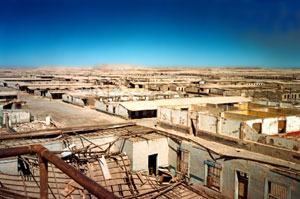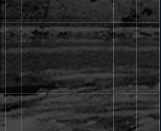
Overview
of Chacabuco, the abandoned mining town in Chile's northern
desert, used by the military as a concentration camp for political
prisoners during the early years of the dictatorship.
Photo Copyright © Joanne Pottlitzer, 1995 |
Those
1,000 days [of Allende’s Popular Unity government] seemed like
one single day, one single day and one single night -- until September
11. All that had been elation, street parties, dance, murals of
that time became overshadowed by another reality, like a magnificent
sunny day that suddenly begins to cloud over, and there is a horrible
storm.
From
September 14, 1973, until the middle of 1974, I was held prisoner
in different jails. I was at the National Stadium until they closed
it on November 9 [1973], and in Chacabuco for six months. A next-door
neighbor turned me in. But I knew they had to find me sooner or
later. I think there were two people the military wanted to use
as examples: Victor and me. That day [September 11] Victor was at
the Technical University, and that very day they arrested him. I
fell three days later. I’ve always said, very seriously, that
I’m alive thanks to the death of Victor. It was about who they
got first, who to use as an example: "This is what happens
to little singers for getting involved in politics." My experience
in the National Stadium is very painful -- I have it repressed.
One day I’ll get it out. Maybe the most important thing that
can be said is that once we were in prison, and everyone knew that
we were there, we developed a cultural program inside the jails
of Chile, an enormous program. There were hundreds of cultural agitators
in prison. There came a time when it was much more to the dictatorship’s
advantage to send us abroad than to keep us in the jails, because
we were making more noise inside than outside.
In Chacabuco, the camp in the north, we lived in pavilions, houses
that had belonged to the nitrate mining town of Chacabuco when the
English were there at the beginning of the 20th century. When copper
replaced nitrate as our principal export, the mine and the houses
were eventually abandoned. (Salvador Allende had decided to make
that mining town into the first national monument to the working
class. He got as far as inaugurating it, and then workers ended
up there as prisoners, along with artists.) There were two rooms,
a small patio and a hot plate where we prepared our meals. The houses
had no roofs. We covered them with canvas. We covered doors and
windows with arpilleras [The patchwork craft done by women
who participated in workshops created in early 1974 by the Pro Peace
Committee to relieve their tensions and anxieties. The women were
usually from working-class neighborhoods; their husbands, partners,
sons or fathers had lost their jobs or had been detained and disappeared].
I remember Gonzalo Palta, an actor who was a fellow prisoner there,
directed one of the theater groups in Chacabuco. A young man who
had directed a chorus in the Communist Youth organization mounted
a chorale with more than 400 prisoners. We created mural newspapers.
There were many journalists in the jails and excellent illustrators
and caricaturists, so we didn’t need photographers -- besides,
we didn’t have cameras. They drew with pencils. Once it was
known that you were in prison, we could receive packages from outside,
with food, with books, with materials to write with. Some of us
wrote poetry while we were there.
|
|


